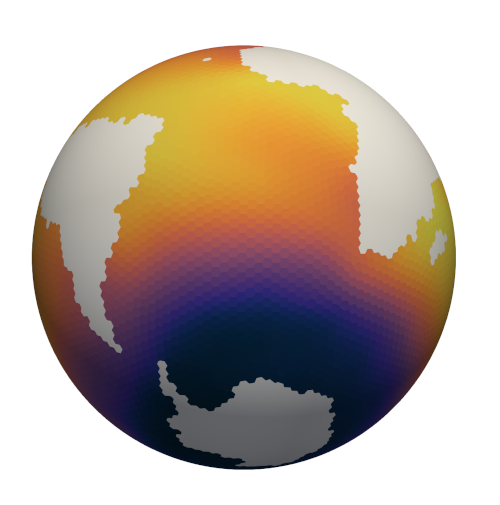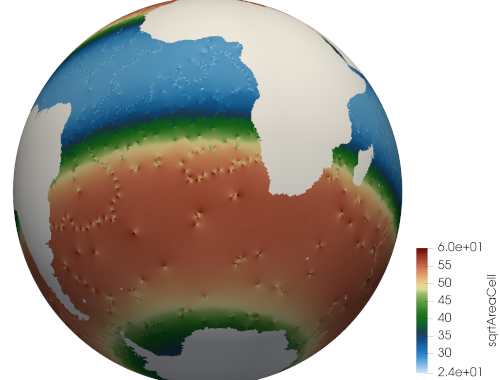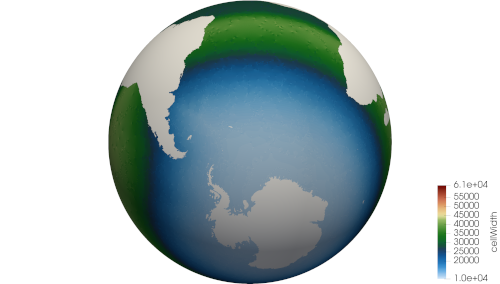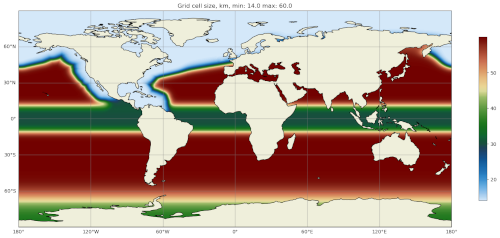global_ocean¶
The ocean/global_ocean test group defines meshes,
initial conditions, testing, and spin-up for global, realistic ocean domains.
Currently, two mesh resolutions—QU240 and
EC30to60, along with their variants with
Ice-shelf cavities—have been ported from COMPASS legacy,
with many more to follow in the coming months.

compass will be the tool used to create ocean meshes and initial conditions for future versions of E3SM.
The global_ocean test group a test case for creating each mesh, test
cases for creating each of the 4 supported initial-conditions variants using
that mesh, a number of test cases aimed at regression testing, and a spin-up
test case for each mesh that produces an initial condition appropriate for
incorporation into E3SM. (compass does not provide the tools for
creating many of the files needed for full E3SM coupling, a process that
requires expert help from the E3SM development team.)
Metadata¶
Most global_ocean test cases produce output files in NetCDF format. The
MPAS development team decided in April 2020
to add a standardized set of metadata to these files to document the mesh and
initial condition, and to provide provenance describing the environment used to
create the mesh.
compass adds the following fields to most NetCDF files (those related to the initial condition are not added to mesh files, because the initial condition is not yet known at the time of mesh creation):
:MPAS_Mesh_Short_Name = "QU240E2r1" ;
:MPAS_Mesh_Long_Name = "QU240kmL16E3SMv2r1" ;
:MPAS_Mesh_Prefix = "QU" ;
:MPAS_Mesh_E3SM_Version = "2" ;
:MPAS_Mesh_Pull_Request = "https://github.com/MPAS-Dev/compass/pull/28" ;
:MPAS_Mesh_QU_Revision = "1" ;
:MPAS_Mesh_QU_Version_Author = "Xylar Asay-Davis" ;
:MPAS_Mesh_QU_Version_Author_E-mail = "xylar@lanl.gov" ;
:MPAS_Mesh_QU_Version_Creation_Date = "210116" ;
:MPAS_Mesh_QU_Minimum_Resolution_km = "240" ;
:MPAS_Mesh_QU_Maximum_Resolution_km = "240" ;
:MPAS_Mesh_QU_Maximum_Depth_m = "3000.0" ;
:MPAS_Mesh_QU_Number_of_Levels = "16" ;
:MPAS_Mesh_Description = "MPAS quasi-uniform mesh for E3SM version 2 at 240-km global resolution with 16 vertical level" ;
:MPAS_Mesh_Bathymetry = "Bathymetry is from GEBCO 2019, combined with BedMachine Antarctica around Antarctica." ;
:MPAS_Initial_Condition = "Polar science center Hydrographic Climatology (PHC)" ;
:MPAS_Mesh_COMPASS_Version = "1.0.0" ;
:MPAS_Mesh_JIGSAW_Version = "0.9.12" ;
:MPAS_Mesh_JIGSAW-Python_Version = "0.2.1" ;
:MPAS_Mesh_MPAS-Tools_Version = "0.2.0" ;
:MPAS_Mesh_NCO_Version = "4.9.7" ;
:MPAS_Mesh_ESMF_Version = "8.0.1" ;
:MPAS_Mesh_geometric_features_Version = "0.1.13" ;
:MPAS_Mesh_Metis_Version = "5.1.0" ;
:MPAS_Mesh_pyremap_Version = "0.0.8" ;
Most of these options can be modified by the user by editing config options. The most convenient way to do this is to add them to the user config file when you are Setting up test cases or Test Suites. In particular, you may wish to set:
# options for global ocean testcases
[global_ocean]
## metadata related to the mesh
# whether to add metadata to output files
add_metadata = True
# the date the mesh was created as YYMMDD, typically detected automatically
creation_date = autodetect
# The following options are detected from .gitconfig if not explicitly entered
author = autodetect
email = autodetect
# The URL of the pull request documenting the creation of the mesh
pull_request = <<<Missing>>>
Meshes¶
The process for creating global ocean meshes is described below in the mesh test case. compass currently supports 5 meshes. Two are at such coarse horizontal resolution (240 km) that they are mostly useful for testing purposes, not scientific simulations. Two more meshes, which vary in resolution between 30 and 60 km, are used as the lowest resolution meshes in E3SM’s science campaigns. The final mesh has resolution focused in the Southern Ocean around Antarctica.
QU240¶
The quasi-uniform 240-km (QU240) mesh, is a global mesh with approximately 240-km horizontal resolution everywhere (as the name implies). Ice-shelf cavities around Antarctica are excluded from the mesh. This mesh is used as part of the nightly test suite to perform regression and performance testing in a coarse but realistic model configuration. This mesh is also being used in studies of climate reproducibility.
QUwISC240¶
The quasi-uniform 240-km mesh with ice-shelf cavities (QUwISC240) is nearly identical to the QU240 except that it includes the Ice-shelf cavities around Antarctica in the ocean domain.
MPAS-Ocean’s treatment of ice-shelf cavities requires and iterative adjustment
step to make the landIcePressure compatible with the ssh (see
Sea surface height adjustment). This process is relatively time consuming,
requiring a short forward run for each iteration, meaning that QUwISC240 is
less efficient for regression and performance testing than QU240. However,
it is useful for low-resolution testing that exercises compass and MPAS-Ocean
functionality related to ice-shelf cavities and sub-ice-shelf freshwater
fluxes.
EC30to60¶
The eddy-closure 30- to 60-km (EC30to60) mesh is the coarsest MPAS-Ocean mesh used for scientific simulations. It is coarse enough that it requires the Gent-McWilliams eddy closure <https://doi.org/10.1175/1520-0485(1990)020<0150:IMIOCM>2.0.CO;2> as a parameterization of mixing from mesoscale ocean eddies.

The image above shows the resolution (as measured by \(\sqrt{A_c}\), where \(A_c\) is the area of a cell in the mesh). The resolution is approximately zonally invariant and transitions smoothly between three target resolutions as a function of latitude: ~30 km at around the equator, ~60 km at mid-latitudes and ~35 km near the the poles.
ECwISC30to60¶
The eddy-closure 30- to 60-km mesh with ice-shelf cavities (ECwISC30to60) is nearly identical to the EC30to60 except that it includes the Ice-shelf cavities around Antarctica in the ocean domain.

A variant of this mesh has been used for low resolution simulations as part of the E3SM v1 Cryosphere Campaign.
SOwISC12to60¶
The Southern Ocean 12- to 60-km mesh with ice-shelf cavities (SOwISC12to60), sometimes called the Southern Ocean regionally refined mesh (SORRM) is intended to be the main simulation mesh for the E3SM v2 Cryosphere Science Campaign.
The mesh has 12 km resolution around Antarctica, tapering to 45 km in mid Southern latitudes, 30 km at the equator and in the North Atlantic, 60 km in the North Pacific, and 35 km in the Arctic. The mesh includes the Ice-shelf cavities around Antarctica in the ocean domain.

WC14¶
The Water Cycle 14- to 60-km mesh (WC14) is intended to be the main regionally refined simulation mesh for the E3SM v2 Water Cycle Science Campaign.
The mesh has 14 km resolution around the continental US, Arctic Ocean and parts of the North Atlantic, tapering to 60 km in mid latitudes, 30 km at the equator, and 35 km around Antarctica.

Ice-shelf cavities¶
As discussed in Ice shelf-cavities, the inclusion of ice-shelf cavities and melt rates below ice shelves around Antarctica is a major objective of the E3SM Cryosphere Campaign.
Each of the global_ocean Meshes can support a variant
with ice-shelf cavities along with one without. Meshes with cavities include
the wISC suffix for “with ice-shelf cavities” attached to the mesh prefix
(e.g. QU or EC). Currently all meshes include both variants but we
anticipate that future meshes may include only the variant with or without
cavities.
Around Antarctica, the topographic data currently used to construct initial conditions in compass comes from BedMachineAntarctica. Because this data set provides the ice draft, rather than the weight of the overlying ice shelf, we use the method for Sea surface height adjustment to update the pressure from the ice shelf to be in dynamic balance with the ice draft.
Biogeochemsitry¶
<<<I need help here!!!>>>
Forward step¶
The only step shared across many global_ocean test cases is forward
(though I doesn’t always go by that name), which integrates the MPAS-Ocean
model in time in “forward” mode.
As a user, your main way of altering forward runs is by changing namelist
options directly in namelist.ocean or modifying streams in
streams.ocean. However, there are a few parameters related to forward runs
you can change in the config file for a test case. Since some test cases like
restart_test test case and :ref`global_ocean_dynamic_adjustment` have
more than one forward run, it is convenient to change options like
forward_cores once in the config file, knowing that this will change the
target number of cores of all forward model runs in the test case. The same
applies to the other forward_* config options that change the minimum cores
allowed, the number of threads, and (in the future) the maximum memory and disk
usage.
Test cases¶
global_ocean includes 9 types of test cases (each with different versions
for different meshes, initial conditions, time integrators, etc.).
mesh test case¶
The ocean/global_ocean/<mesh>/mesh test case (where <mesh> is the name
of a mesh, e.g. QU240) creates a “base” horizontal
mesh covering the globe with a distribution of resolution according to the
specifications of the mesh. The base mesh is created using the
JIGSAW and
JIGSAW-Python tools. Then, a
mask for “land” (i.e. non-ocean) cells is created and the mesh is culled so
that only ocean cells are retained. The data set determining which cells are
land vs. ocean depends on whether ice-shelf cavities are included in the mesh
or not (see Ice-shelf cavities). A coastline from
Natural Earth
is combined with either the edge of Antarctic Ice Sheet (AIS) or the edge of the
grounded portion of the AIS from
BedMachineAntarctica.
These coastlines come from the
geometric_features package.
For most meshes, tools and data sets from the
geometric_features and from the
mpas_tools package are used to
ensure that some transects such the thin opening at Gibraltar connecting the
Mediterranean Sea to the Atlantic Ocean (so-called “critical passages”) are
represented by contiguous ocean cells while others such as the Antarctic
Peninsula (so-called “critical land blockages”) are blocked by land with no
ocean connectivity.
As part of culling the mesh, adding critical passages, and removing critical land blockages, there is also a step in which a “flood fill” is performed to ensure that all parts of the global ocean are connected to one another by at least one neighboring cell.
init test case¶
Once the horizontal mesh has been created, the next step is to create a vertical mesh and and initial condition.
The default vertical coordinate depends on the mesh being used, as described
in Meshes. Possible grid types are described in
Vertical coordinate and include uniform, tanh_dz, 60layerPHC,
and 100layerE3SMv1.
compass supports two different types of initial conditions. One is derived from the Polar science center Hydrographic Climatology (PHC). The other is the UK MetOffice’s EN4 estimated climatology for the year 1900 (EN4_1900).
Either initial condition can also be combined with ecosystem tracers used in simulations with active Biogeochemsitry if ocean biogeochemsitry is enabled. This dataset is from <<<need some help here!!!>>>.
Thus, there are 4 combinations of initial conditions, PHC, PHC_BGC,
EN4_1900 and EN4_1900_BGC. All subsequent tests
(performance_test test case, restart_test test case, etc.)
could potentially start from any of these initial conditions, meaning that
a performance test starting from PHC should be thought of as a different test
from one starting from EN4_1900. Therefore, it is convenient to house both
the init test case and all subsequent test cases that depend on it within
a subdirectory with the name of the initial condition. The relative paths
associate with each initial condition for a given <mesh> are:
ocean/global_ocean/<mesh>/PHC/initocean/global_ocean/<mesh>/PHC_BGC/initocean/global_ocean/<mesh>/EN4_1900/initocean/global_ocean/<mesh>/EN4_1900_BGC/init
performance_test test case¶
The performance_test test case runs a short forward integration, then
performs validation of prognostic variables (layer thickness, velocity,
temperature and salinity) and, if applicable, variables related to fluxes
below ice shelves and those associated with Biogeochemsitry. The
duration of the forward run depends on the mesh and the time integrator.
Depending on the mesh, versions of the test may exist with both or either of
the split-explict (base on Higdon 2005)
or the 4th-order Runge-Kutta
(RK4) time
integrator. Each of these possible variants is given its own subdirectory.
Thus, for a given mesh <mesh> and initial condition <ic>, one or
more of these versions of the performance_test will be available:
ocean/global_ocean/<mesh>/<ic>/performance_test/split_explicitocean/global_ocean/<mesh>/<ic>/performance_test/RK4
Versions of this test cases is currently available for all meshes, but not necessarily for all combinations of initial conditions and time integrators.
restart_test test case¶
The restart_test test case runs a short forward integration, saving an
intermediate restart file. Then, in a second forward step, the test continues
the run from the restart file. Output from the two steps (full_run and
restart_run) are compared to make sure prognostic variables (layer
thickness, velocity, temperature and salinity) are unchanged.
As with the performance_test test case, restart_test can
be run with either or both of the split-explicit or RK4 time integrator. Thus,
for a the QU240 or QUwISC240
mesh (currently the only supported meshes) and initial condition <ic>, one
or more of these versions of the restart_test will be available:
ocean/global_ocean/QU240/<ic>/restart_test/split_explicitocean/global_ocean/QU240/<ic>/restart_test/RK4ocean/global_ocean/QUwISC240/<ic>/restart_test/split_explicitocean/global_ocean/QUwISC240/<ic>/restart_test/RK4
decomp_test test case¶
The decomp_test test case runs a short forward integration with 4 cores
(4proc) and then performs the same run again in another step with 8 cores
(8proc). Prognostic variables (layer thickness, velocity, temperature and
salinity) are compared to make sure they are unchanged.
As with the performance_test test case, decomp_test can
be run with either or both of the split-explicit or RK4 time integrator. Thus,
for a the QU240 or QUwISC240
mesh (currently the only supported meshes) and initial condition <ic>, one
or more of these versions of the decomp_test will be available:
ocean/global_ocean/QU240/<ic>/decomp_test/split_explicitocean/global_ocean/QU240/<ic>/decomp_test/RK4ocean/global_ocean/QUwISC240/<ic>/decomp_test/split_explicitocean/global_ocean/QUwISC240/<ic>/decomp_test/RK4
threads_test test case¶
The threads_test test case runs a short forward integration with 1 thread
and 4 cores (1thread) and then performs the same run again in another step
with 2 threads and 4 cores (2thread). Prognostic variables (layer
thickness, velocity, temperature and salinity) are compared to make sure they
are unchanged.
As with the performance_test test case, threads_test can
be run with either or both of the split-explicit or RK4 time integrator. Thus,
for a the QU240 or QUwISC240
mesh (currently the only supported meshes) and initial condition <ic>, one
or more of these versions of the threads_test will be available:
ocean/global_ocean/QU240/<ic>/threads_test/split_explicitocean/global_ocean/QU240/<ic>/threads_test/RK4ocean/global_ocean/QUwISC240/<ic>/threads_test/split_explicitocean/global_ocean/QUwISC240/<ic>/threads_test/RK4
analysis_test test case¶
The analysis_test is used to test the proper function and validate the
output from a large number of MPAS-Ocean’s “analysis members”. Analysis
members allow MPAS-Ocean to compute analysis during the model run, meaning
much of the same infrastructure and functionality used in the forward model
can also be used for analysis. Analysis members are also useful for analysis
that is too large or time consuming to perform after the simulation has
completed, or where storing the required data to disk would be infeasible.
The analysis members tested in this test case are:
globalStatssurfaceAreaWeightedAverageswaterMassCensuslayerVolumeWeightedAveragezonalMeanokuboWeissmeridionalHeatTransporthighFrequencyOutputeliassenPalmmixedLayerDepthsdebugDiagnosticseddyProductVariablesoceanHeatContentmixedLayerHeatBudget
For more information on these analysis members, see the MPAS-Ocean user’s guide.
As with the performance_test test case, analysis_test can
be run with either or both of the split-explicit or RK4 time integrator. Thus,
for a the QU240 or QUwISC240
mesh (currently the only supported meshes) and initial condition <ic>, one
or more of these versions of the analysis_test will be available:
ocean/global_ocean/QU240/<ic>/analysis_test/split_explicitocean/global_ocean/QU240/<ic>/analysis_test/RK4ocean/global_ocean/QUwISC240/<ic>/analysis_test/split_explicitocean/global_ocean/QUwISC240/<ic>/analysis_test/RK4
daily_output_test test case¶
The daily_output_test is similar to the analysis_test test case:
it is used to run and validate the timeSeriesStatsDaily analysis member.
The reason for a separate test is that the daily_output_test must run for
a full day to produce useful output, significantly longer than the
analysis_test test case.
The timeSeriesStatsDaily performs daily averages of a large number of
model variables. The variables in this test are kept in sync with the default
output of the timeSeriesStatsMonthly analysis member used in E3SM. This
test is used to gain confidence that E3SM output from MPAS-Ocean will have the
expected variables and formatting. For example, the test is currently being
used in an effort to improve compliance to the
CF Conventions <https://cfconventions.org/> in the output metadata.
As with the performance_test test case, daily_output_test can
be run with either or both of the split-explicit or RK4 time integrator. Thus,
for a the QU240 or QUwISC240
mesh (currently the only supported meshes) and initial condition <ic>, one
or more of these versions of the daily_output_test will be available:
ocean/global_ocean/QU240/<ic>/daily_output_test/split_explicitocean/global_ocean/QU240/<ic>/daily_output_test/RK4ocean/global_ocean/QUwISC240/<ic>/daily_output_test/split_explicitocean/global_ocean/QUwISC240/<ic>/daily_output_test/RK4
dynamic_adjustment test case¶
One of the main purposes of compass is to provide a way of spinning up MPAS-Ocean initial conditions to dissipate transients that result from starting the simulation from rest. Particularly for high resolution meshes, surface waves with fast time scales and large amplitude must be damped (by applying Rayleigh friction), first aggressively, then more gently, before damping is disabled.
The dynamic_adjustment test case is implemented differently for each of the
Meshes. For example, for the QU240
and ref:global_ocean_mesh_quwisc240 meshes, we perform only 1 day of damping
(and even this is likely unnecessary), followed by a 1-day simulation without
damping. In contrast, for the EC30to60
and ref:global_ocean_mesh_ecwisc30to60 meshes, we perform a 10-day spin-up
with aggressive damping, followed by 10 more days without damping. Higher
resolution meshes in Legacy COMPASS require several stages of damping,
each over several days before damping can be removed.
As with the performance_test test case, dynamic_adjustment can
be run with either or both of the split-explicit or RK4 time integrator.
Thus, for a given mesh <mesh> and initial condition <ic>, one or
more of these versions of the performance_test will be available:
ocean/global_ocean/<mesh>/<ic>/dynamic_adjustment/split_explicitocean/global_ocean/<mesh>/<ic>/dynamic_adjustment/RK4
Versions of this test cases is currently available for all meshes, but not necessarily for all combinations of initial conditions and time integrators.
The qu240_for_e3sm test suite, quwisc240_for_e3sm test suite, ec30to60 test suite and ecwisc30to60 test suite are Test suites designed to make it easier to run the standard dynamic-adjustment test cases for each mesh along with the related mesh test case, init test case, and files_for_e3sm test case.
files_for_e3sm test case¶
After running the dynamic_adjustment test case, users may be interested in
preparing a number of files needed for including a new mesh in E3SM. These
files include: MPAS-Ocean and MPAS-Seaice initial conditions (including
Metadata);
SCRIP files;
partition files, created with
gpmetis, for
splitting the mesh across a number of possible core counts; a mask file for
MPAS-Ocean’s mocStreamfunction analysis member; and mask and mapping files
for MPAS-Analysis.
The resulting files are symlinked in a subdirectory of the test case called
assembled_files. This directory contains subdirectories with the same
structure as the E3SM data server.
For new meshes, these files can be uploaded by an expert from the E3SM team
along with additional files required for full E3SM integration. Currently,
there is not a way to use new meshes in E3SM without help from an expert from
the E3SM team.
make_diagnostic_files test case¶
Sometimes, we already have an E3SM initial condition but the diagnostics files for MPAS-Analysis either weren’t created with the initial condition or they are out of date.
The user should create a local symlink to an E3SM initial condition for MPAS-Ocean ofr the desired mesh. Then, the config options in make_diagnostics_files.cfg should be edited. In this example, we have created a local link to the ocean.WCAtl12to45E2r4.210318.nc initial condition in the test case directory. The mesh name has also been set to the E3SM short name for this mesh WCAtl12to45E2r4. We use all 36 cores on a node (this test case can’t use multiple nodes for most steps). We indicate that the mesh does not include ice-shelf cavities, which means we don’t compute masks for ice-shelf melt rates.
[make_diagnostics_files]
mesh_name = WCAtl12to45E2r4
mesh_filename = ocean.WCAtl12to45E2r4.210318.nc
cores = 36
with_ice_shelf_cavities = False
The resulting files are symlinked in a subdirectory of the test case called
assembled_files. This directory contains subdirectories with the same
structure as the E3SM data server.
These files can be uploaded by an expert from the E3SM team. We ask that
users not try to upload the files themselves without consulting an expert from
the team.